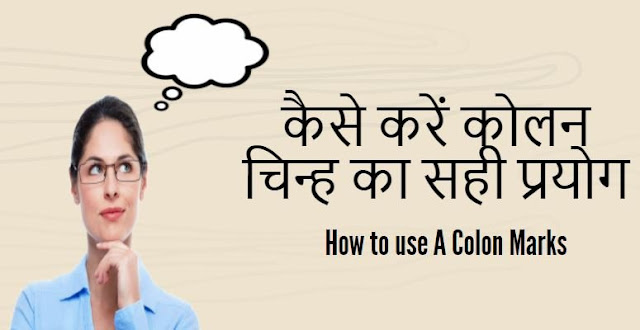कैसे करें कोलन चिन्ह का सही प्रयोग – How to use A Colon Marks

Contents
- 1 कैसे करें कोलन चिन्ह का सही प्रयोग – How to use A Colon Marks
- 1.1 Colon – कोलन – कोलन (:-)
- 1.2 How to Use a Colon (:) Correctly
- 1.3 Introducing a List
- 1.4 Explaining or Expanding on a Statement
- 1.5 Before a Quotation
- 1.6 Between Independent Clauses (When the Second Explains the First)
- 1.7 In Formal Salutations (Letters & Emails)
- 1.8 In Time, Ratios, and Titles
- 1.9 Quick Summary
कैसे करें कोलन चिन्ह का सही प्रयोग – How to use A Colon Marks
Colon – कोलन – कोलन (:-)
कोलन चिन्ह (Colon Mark) अर्ध विराम (Semicolon ) से भी अधिक विराम का संकेत करता है इसके बाद हमेशा डेस () Desh का चिन्ह लगाया जाता है
कोलन चिन्ह (Colon Mark) का प्रयोग किसी भी उद्धरण (Quotation) पहले किया जाता है
Example – Becon says :- Reading makes a full man,writing an exact man,speaking a ready man .
कोलन चिन्ह (Colon Mark) का प्रयोग किसी भी वस्तु की सूची या गणना अथवा उदहारण से पहले किया जाता है
Example –The Parts of a verb in English are : The Present Tense,The Past Tense , The Past Participal
कोलन चिन्ह (Colon Mark) का प्रयोग ऐसे वाक्यों के लिए भी किया जाता है जो अर्थ द्वारा एक दुसरे निकट रूप से जुड़े हो
How to Use a Colon (:) Correctly
A colon (:) is a punctuation mark used to introduce, emphasize, or explain information. Here’s how you can use it properly:
Introducing a List
Use a colon before listing items, especially after an independent clause.
Example:
-
I need to buy the following groceries: milk, eggs, bread, and butter.
-
There are three primary colors: red, blue, and yellow.
Incorrect:
-
I need to buy: milk, eggs, bread, and butter. (The sentence before the colon must be complete.)
Explaining or Expanding on a Statement
Use a colon to introduce an explanation, definition, or further details.
Example:
-
She finally got what she always wanted: a promotion at work.
-
There’s only one way to succeed: work hard and stay focused.
Before a Quotation
Use a colon before a quotation, especially if it follows an independent clause.
Example:
-
The teacher’s advice was clear: “Always proofread your work before submitting it.”
Incorrect:
-
The teacher said: “Always proofread your work before submitting it.” (Use a comma here, not a colon.)
Between Independent Clauses (When the Second Explains the First)
A colon can separate two independent clauses if the second explains or summarizes the first.
Example:
-
He was right: the weather did turn bad.
-
There was only one option left: leave immediately.
Incorrect:
-
He was right: And the weather did turn bad. (The second part should not start with a conjunction.)
In Formal Salutations (Letters & Emails)
Use a colon after the greeting in formal letters.
Example:
-
Dear Hiring Manager:
-
To Whom It May Concern:
Incorrect:
-
Dear Sir, (In informal letters, use a comma instead.)
In Time, Ratios, and Titles
A colon is also used in time formats, ratios, and titles.
Example:
-
The train departs at 10:30 AM.
-
The ratio of sugar to flour is 2:1.
-
My favorite book is “Shakespeare: The Complete Works.”
Quick Summary
Use a colon to introduce a list, explanation, quotation, or second clause that explains the first.
Do NOT use a colon right after a verb or preposition.
Use a colon in formal letters, time, ratios, and titles.
Want more examples or practice exercises?
